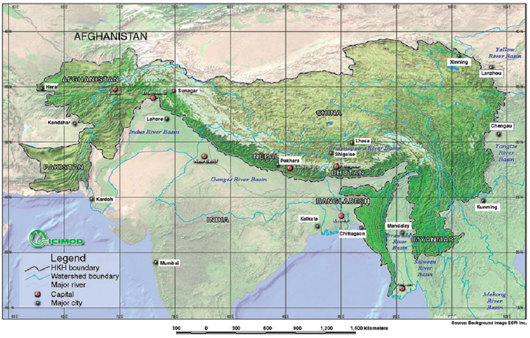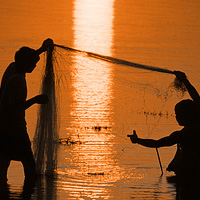
Himalayas (Hindu-Kush)
Contact Information
- Prof. Xu Jianchu
Program Manager, Water Hazard and Environmental Management
International Centre for Integrated Mountain Development
P.O. Box 3226, Kathmandu, Nepal
jxu@icimod.org
Lead Institution
International Centre for Integrated Mountain Development (ICIMOD).
Funding
This assessment received funding and in-kind contributions from: ICIMOD and member countries, and other donor agencies.
Project Summary
The water resources of the Himalayan region (Figure 1), extending over 3,500 kilometers from west to east, sustains approximately 150 million people and has major impacts on the lives of three times as many people living in the river basins downstream. The Himalayan region is shared by eight countries: Afghanistan, Bangladesh, Bhutan, China, India, Myanmar, Nepal and Pakistan, interleaving with Asia’s eight major river basins – the Indus, Ganges, Brahmaputra, Irrawaddy, Salween, Mekong, Yangtse, and Yellow River. This, the highest mountainous region in the world is characterized by great geological, biological and cultural diversity, as well as extensive marginalization and poverty among its people. Landscapes in the Himalayan region compose a complex mosaic of barren mountain faces, glaciers, alpine meadow and wetlands at high altitudes; human settlement, farmland, home gardens, lakes, and rangeland at medium altitudes; and paddy and wetlands at lower altitudes: a range of habitats for all life forms and a diversity of livelihoods. This great diversity, characteristic of most mountain regions, makes these regions highly sensitive to climate change and variability.

Figure 1. Hindu-Kush Himalayas assessment ecoregion.
The overall objective of this assessment is to provide credible, salient and legitimate information and knowledge of mountain ecosystem services to facilitate trade-off and incentive (compensation) mechanisms for poverty alleviation and environmental enhancement in the Hindu-Kush Himalayas (HKH) mountains. Specific objectives include:
- providing credible, salient and legitimate information on mountain ecosystem services in terms of provisioning, regulating, and supporting services, and cultural heritage;
- measuring the pace of Himalayan environmental change and the consequences to local, regional, and global beneficiaries;
- identifying the drivers of environmental change;
- developing scenarios of the future for ecosystem services;
- support for policy responses in general, trade-off options in particular at the local and national levels;
- disseminating information and knowledge for decision-making and public awareness;
- building capacity among individuals, communities and institutions of the Himalayas, particularly on the science-policy interface for the effective use of research findings.
References
- Xu J., Erzi, M., Duojie, T., Yongshou, F., Zhi, L. and Melick, D. (2005). Integrating Sacred Knowledge for Conservation: Cultures and Landscapes in Southwest China, Ecology and Society 10(2): 7. [online] URL: http://www.ecologyandsociety.org/vol10/iss2/art7/
- Xu J. and Rana, G.M. (2005). Living in the Mountains. In Terry Jeggle (ed): Know Risk, United Nations Inter-agency secretariat of the International Strategy for Disaster Reduction, pp.196-199.
- Xu, J.C. and Wilkes, A. (2005). State Simplifications of Land Use and Biodiversity in the Uplands of Yunnan, Eastern Himalayan region. In Global Change and Mountain Regions: an Overview of Current Knowledge ( eds. U.M. Huber, H.K.M. Bugmann, and M. A. Reasoner) pp.541-550. The Netherlands.
- Xu J. (2006). The Political, Social and Ecological Transformation of a landscape: The case of rubber in Xishuangbanna, China. Mountain Research and Development, 26(3): 254-262.
- Melick, D. Xuefei, Y., Yongping, Y. and Xu, J. (2006). Establishing Long-term Biodiversity Assessment and Monitoring in NW Yunnan, China: a growing need for baseline information. Mountain Research and Development, 26(3): 292-294.
- Xu, J. and Melick, D. (2006). Rethinking the effectiveness of public protected areas in southwestern China. Conservation Biology (forthcoming).
- Xu, J. (2006). Towards a safer and just mountain habitat for all. International Centre for Integrated Mountain Development, No 50 , summer 2006: 4-10. ISSN 1013-7386 (Towards a safer and just mountain habitat for all).
|

|